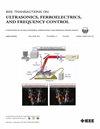A 2-D Circular Array Transducer for Endoscopic Ultrasound Imaging of Tube
IF 3
2区 工程技术
Q1 ACOUSTICS
IEEE transactions on ultrasonics, ferroelectrics, and frequency control
Pub Date : 2024-12-05
DOI:10.1109/TUFFC.2024.3509474
引用次数: 0
Abstract
The concept of endoscopic ultrasound (EUS) has been introduced to nondestructive testing (NDT) for the inspection of tubular structure. However, the fixed normal focusing beam of the present EUS transducers obstructs imaging flexibility and limits the robustness of the inspection, particularly for planar reflectors. To address this challenge, a 2-D circular array (2-D CA) designed for 3-D focusing is developed in this article. A prototype 2-D CA transducer is fabricated and validated, which is demonstrated as a central frequency of 10.10 MHz and an average pulse duration of no more than 344 ns. An independent-dual-focusing (IDF) beamforming scheme is further proposed, providing delay laws in two orthogonal directions. The acoustic field simulation results confirm that the 2-D CA is capable of achieving focusing in any direction, thereby enhancing the flexibility of EUS imaging. The imaging performance of the 2-D CA is evaluated through the immersion EUS inspection of a stainless-steel tube specimen. All the quasiplanar reflectors, including ring grooves with narrow-width, small-diameter flat bottom holes (FBHs), and longitudinal grooves, are successfully detected in the 2-D CA imaging results. These reflectors could hardly be recognized by the conventional CA with a fixed-normal beam, affirming the superior detection robustness of the 2-D CA. The detection signal-to-noise ratio (SNR) and error of quantitative characterization of the 2-D CA are 26.12 dB higher and 40.37% lower than those of conventional CA, respectively. The proposed 2-D CA enables novel and advanced EUS imaging modalities, which have potential applications in both medical imaging and NDT domains.用于管内超声内镜成像的二维圆形阵列换能器
超声内镜(EUS)的概念已被引入到管状结构的无损检测(NDT)中。然而,目前EUS换能器的固定法向聚焦光束阻碍了成像的灵活性,限制了检测的稳健性,特别是对于平面反射器。为了解决这一挑战,本文开发了一种用于三维聚焦的二维圆形阵列(2-D CA)。制作并验证了二维CA换能器的原型,其中心频率为10.10 MHz,平均脉冲持续时间不超过344 ns。进一步提出了一种独立双聚焦(IDF)波束形成方案,该方案提供了两个正交方向上的延迟规律。声场模拟结果证实了二维CA能够实现任意方向的聚焦,从而增强了EUS成像的灵活性。通过浸入式EUS检查不锈钢管试样来评估二维CA的成像性能。所有的准平面反射面,包括窄宽度环槽、小直径平底孔(FBHs)和纵向槽,都能在二维CA成像结果中被成功检测到。这些反射面很难被固定法向波束的常规CA识别,证明了二维CA具有较好的检测鲁棒性。二维CA的检测信噪比和定量表征误差分别比常规CA高26.12 dB和40.37%。提出的2-D CA实现了新颖和先进的EUS成像模式,在医学成像和无损检测领域都有潜在的应用。
本文章由计算机程序翻译,如有差异,请以英文原文为准。
求助全文
约1分钟内获得全文
求助全文
来源期刊
CiteScore
7.70
自引率
16.70%
发文量
583
审稿时长
4.5 months
期刊介绍:
IEEE Transactions on Ultrasonics, Ferroelectrics and Frequency Control includes the theory, technology, materials, and applications relating to: (1) the generation, transmission, and detection of ultrasonic waves and related phenomena; (2) medical ultrasound, including hyperthermia, bioeffects, tissue characterization and imaging; (3) ferroelectric, piezoelectric, and piezomagnetic materials, including crystals, polycrystalline solids, films, polymers, and composites; (4) frequency control, timing and time distribution, including crystal oscillators and other means of classical frequency control, and atomic, molecular and laser frequency control standards. Areas of interest range from fundamental studies to the design and/or applications of devices and systems.

 求助内容:
求助内容: 应助结果提醒方式:
应助结果提醒方式:


